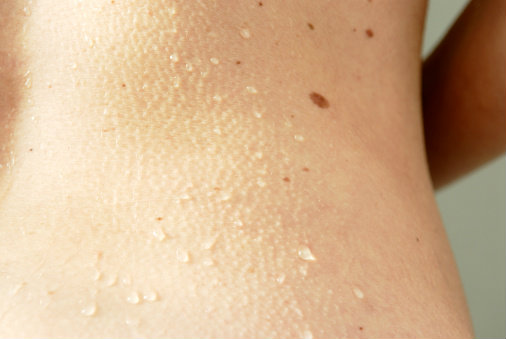ทำไมเราจึงเกิด อาการขนลุก

 Why Do We Get Goose Bumps?
Why Do We Get Goose Bumps?
When we feel chills down our spines, whether they are triggered by cold or fear, an involuntary response kicks in and causes the hair on our body to stand up. This effect is called "goose bumps," as the bumps on our skin have the appearance of a plucked goose. But why do we get goose bumps, and do other animals get goose bumps as well? In this issue, we will look at the physiology of goose bumps.
Goose bumps occur as a response to the hormone adrenaline, which induces muscle contractions around the bases of our hair, lifting the hair up and causing tiny elevations of the skin that appear as bumps. In humans, goose bumps are strongest on the forearms, but can also occur on the legs, neck or even on the head. Other mammals, such as chimpanzees, cats, dogs and even porcupines, can also get goose bumps. Goose bumps were designed to keep the body warm, as the expansion of the hair creates an insulation around the body, thus retaining the body's heat. In addition, when the animals feel threatened, the elevated hair helps the animals appear larger in size, thus scaring away their enemies. In the case of the porcupine, goose bumps causes the quills on its body to stand up and sometimes fall off, causing the misconception that the porcupine can use its quills as darts to shoot at its enemy.
At the moment, you may be wondering whether or not the bumps we observe on the plucked goose are classified as goose bumps. The answer is that they are not, since they are not caused by the same type of muscle contractions. Nonetheless, geese and other avian creatures have similar involuntary reflexes that cause their feathers to bristle up to shield themselves from the cold.
Because goose bumps can occur in various types of animals, the next time you find yourself getting goose bumps while watching a scary movie, you might want to glance over and see whether your beloved pet is also watching the movie with its own hair raised, too.
ทำไมเราจึงเกิด อาการขนลุก
หากเรารู้สึกไขสันหลังเย็นวาบ ไม่ว่าจะเกิดจากความเย็นหรือความกลัว ระบบตอบสนองที่อยู่นอก อำนาจจิตใจจะทำให้ขนบนร่างกายของเราลุกตั้ง ซึ่งปรากฏการณ์นี้เรียกว่าขนลุก หรือที่เรียกว่า goose bumps (หนังห่านที่มีความตะปุ่มตะป่ำ) ในภาษาอังกฤษ เนื่องจากลักษณะตุ่มเล็กๆ บนผิวหนังนั้นดูเหมือนผิว ของห่านที่ถูกถอนขนออกไปแล้ว แต่ว่าทำไมเราถึงเกิดอาการขนลุกและสัตว์ชนิดอื่นสามารถเกิดอาการ ขนลุกได้หรือไม่ ในฉบับนี้ เราจะมาศึกษากลไกชีวภาพ ของอาการขนลุกกันค่ะ
อาการขนลุกเป็นการตอบสนองต่อฮอร์โมนที่ เรียกว่าอะดรีนาลิน ซึ่งกระตุ้นให้กล้ามเนื้อรอบรูขุมขนนั้นหดตัวและยกขนให้ตั้งขึ้น ส่งผลให้ผิวหนังนูนขึ้นเป็นตุ่มเล็กๆ อาการขนลุกจะเห็นได้ชัดที่สุดบริเวณปลายแขน แต่ก็สามารถพบได้ที่ขาคอ หรือแม้แต่บน ศีรษะของมนุษย์ นอกจากนั้น อาการขนลุกยังเกิดได้ ในสัตว์เลี้ยงลูกด้วยนมชนิดอื่น เช่น ลิงชิมแปนซี แมว สุนัข และแม้แต่เม่น ซึ่งอาการขนลุกจะช่วยรักษาความ อบอุ่นในร่างกายสัตว์ เพราะขนที่ตั้งชันขึ้นจะทำหน้าที่ เป็นฉนวนเพื่อรักษาอุณหภูมิในร่างกาย และหากสัตว์ รู้สึกว่าถูกคุกคาม ขนที่ตั้งชันขึ้นก็จะช่วยให้มันดูตัวโต ขึ้นเพื่อข่มขู่คู่ต่อสู้ ในกรณีของเม่นนั้น อาการขนลุก ทำให้ก้านขนเม่นตั้งชันและบางครั้งร่วงจากผิวหนังก่อให้เกิดการเข้าใจผิดว่าเม่นสามารถสลัดขนเม่น เหมือนการยิงลูกดอกไปยังศัตรูได้เลยทีเดียว
แต่ตอนนี้คุณอาจสงสัยว่าตุ่มเล็กๆ บนหนัง ห่านที่ถูกถอนขนนั้น จัดว่าเป็นตุ่มที่เกิดจากอาการ ขนลุกด้วยหรือไม่ คำตอบคือไม่ใช่ค่ะ เพราะมันไม่มี การหดตัวของกล้ามเนื้อแบบเดียวกัน อย่างไรก็ตาม ห่านและสัตว์ปีกชนิดอื่นๆ ก็มีระบบตอบสนองที่อยู่ นอกอำนาจจิตใจที่คล้ายคลึงกันค่ะ ซึ่งทำให้ขนของ มันตั้งชันขึ้นเพื่อปกป้องพวกมันจากความหนาวเย็น ได้เช่นกัน
เนื่องจากอาการขนลุกนั้นสามารถเกิดขึ้น ได้ในสัตว์หลายชนิด ดังนั้นคราวหน้าที่คุณรู้สึก ขนลุกขณะดูภาพยนตร์สยองขวัญละก็ อย่าลืม เหลือบตาไปมองสัตว์เลี้ยงแสนรักของคุณด้วย
นะคะ ว่ามันดูหนังแล้วก็กลัวจนขนตั้งชันอยู่เหมือน กันหรือเปล่า
Vocabulary
trigger (v.) ทริกเกอร์ กระตุ้น ทำให้เกิด
pluck (v.) พลัค ดึง เด็ด ถอน
elevation (v.) เอเลเวชัน การยกให้สูงขึ้น
forearm (n.) ฟอร์อาร์ม ส่วนของแขนที่อยู่ระหว่างข้อศอกถึงข้อมือ
porcupine (n.) พอร์คิวไพน์ เม่น
insulation (n.) อินซูเลชัน ฉนวน
bristle (v.) บริซเซิล ตั้งชัน
คอลัมน์ Science Zone
ผู้เขียน วนนิตย์ (I Get English Magazine)





